The techniques of television lighting tell you what instrument to use in what particular position and with what intensity to achieve a desired lighting effect. Since light impressions (in the form of brightness and color) are primarily what the viewer perceives on the television screen, the technique of lighting--or the art of controlling light--is obviously an essential and powerful aspect of production.
A knowledge of these five areas is especially important for mastering the techniques of television lighting: (1) definitions of lighting terms, (2) the photographic, or triangle, lighting principle, (3) additional light sources, (4) special lighting techniques, and (5) operation of lights.
The section on key terms will contain only such definitions that are not already included in the first part of this section.
Since you now know the most important aspects of the lighting tools, let's put them to work.
In small stations, lack of proper equipment, space, time, and manpower influences lighting techniques and usually limits lighting possibilities to a considerable extent. These limitations, however, do not mean that good and creative television lighting is impossible; they simply call for greater ingenuity on the part of the lighting technician.
There are usually many solutions to one problem; therefore, a universal lighting recipe that works for every possible lighting situation cannot and should not be given here. An attempt is made, however, to list some basic lighting principles, which can be easily adapted to specific television lighting problems. You can then adapt these principles to your specific requirements, but do not start with the anticipated limitations. Start with how you would like the lighting to look and then adapt to the existing technical facilities.
Definition of Lighting Terms
You can apply the techniques of television lighting only if you are, first of all, thoroughly familiar with the basic terminology. In lighting for television (as well as for film and still photography) the instruments are labeled according to function, that is, their particular role in the lighting process.
Baselight is an extremely diffused, overall illumination in the studio, coming from no one particular source. A certain amount of baselight is necessary for the technical acceptability of a television picture.
Key light is the apparent principal source of directional illumination falling upon a subject or an area.
Back light is directional illumination coming substantially from behind the subject.
Fill light is a generally diffused light to reduce shadow or contrast range. It can be directional if the area to be "filled in" is rather limited.
Background light or set light is an illumination of the background or set separate from the lights provided for the performers or performing areas.
Side light is a directional light that illuminates the front side of a subject, usually opposite the key light.
Kicker light is a directional illumination from the back, off to one side of the subject, usually from a low angle.
Camera light is a small spotlight mounted on top of the television camera. It is used for additional fill or eye sparkle, as principal light source for objects located in dark corners of the studio, or to provide illumination when another instrument causes the camera to cast an unwanted shadow.
You should realize that there are several variations for these terms; however, most television operations use this terminology as their standard.
=================
Cameo Lighting--Foreground figures are lighted with highly directional light, with the background remaining dark.
Light Angle--The vertical angle of the suspended lighting instrument. A 45-degree angle is considered normal.
Light Ratio--The relative intensities of key, back, and fill. A 1:1 ratio between key and back lights means that both light sources burn with equal intensities. A 1:1/2 ratio between key and fill lights means that the fill light burns with half the intensity of the key light. Because light ratios depend on many other production variables, they cannot be fixed. A key:back:fill ratio of 1:1:1/2 is often used for normal triangle lighting.
Lighting Triangle--Same as Photographic Principle: the triangular arrangement of key, back, and fill lights.
Photographic Principle The triangular arrangement of key, back, and fill lights, with the back light opposite the camera and directly behind the object, and the key and fill lights opposite each other to the front and side of the object. Also called triangle lighting.
Vertical Key Light Position--The relative distance of the key light from the studio floor, specifically with respect to whether it is above or below the eye level of the performer. Not to be confused with high-and low-key lighting, which refers to the relative brightness and contrast of the overall scene.
=================
The Photographic Principle, or Basic Triangle Lighting
As one of the photographic arts, television is subject to photographic lighting principles.
The most basic photographic lighting principle--or, as it is frequently called, basic triangle lighting-consists of three main light sources: (1) key light, (2) back light, and (3) fill light.
Each of the three main instruments is positioned in such a way that it can optimally fulfill its assigned function. This arrangement is the lighting triangle (see 6.1 and 6.2). But what exactly are the functions each instrument is to fulfill? Let's find out.
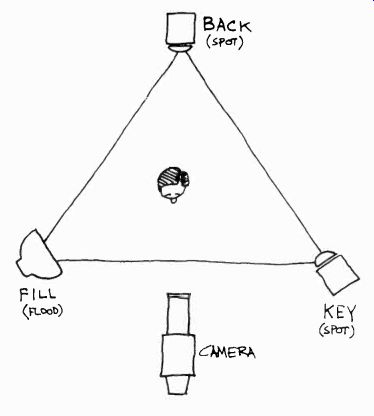
6.1 Basic Photographic Principle: As you can readily see, the three principal
lights, key (spot), back (spot), and fill (flood), form a triangle, with the
back light as its apex, opposite the camera.
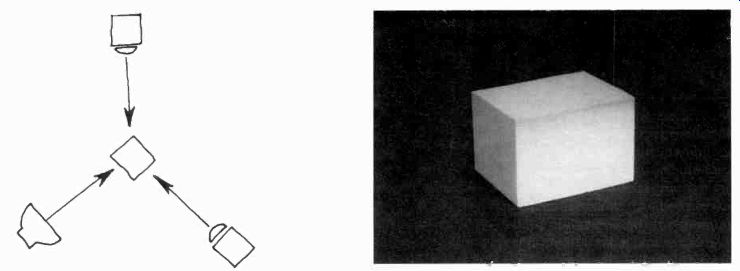
6.2 Basic Triangle Lighting: This is how the photographic principle lighting
appears on the television screen. All three main light sources contribute
to the revelation of the three-dimensional object on a two-dimensional screen.
Functions of Main Light Sources
Each of the three main light sources, key, back, and fill, has to fulfill a very specific function so that the major objective can be reached: the revelation of form and dimension-or, in lighting terms, the manipulation of light and shadow in order to produce the impression of a three-dimensional object on the two-dimensional television screen.
Key Light
As the principal source of illumination, the major function of the key light is to reveal the basic shape of the object (see 6.3). In order to reveal the basic shape, the key light must produce distinct shadows. Fresnel spotlights, medium spread, are normally used for key illumination.
In order to reveal as much of the object as possible, and to conform with our expectancy for the principal light source to come from above, the key light is placed above and to the right or left front side of the object, from the camera's point of view.
If you look at figure 6.3a, which shows the cube illuminated with the key light only, you will notice that the falloff is very fast and that the shadows of the cube blend in with the background, making its true dimension rather ambiguous. To help make the object appear more distinct, we obviously need light sources other than the single key light.
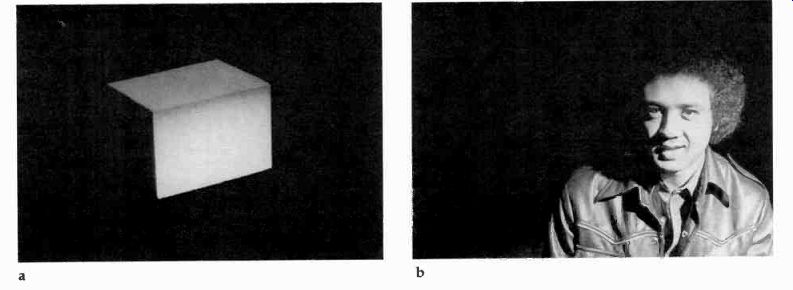
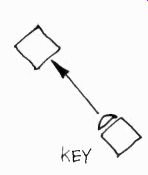
6.3 The key light represents the principal light source and reveals the basic
shape of the object.
Back Light
The back light has several important functions. As you see in figure 6.4a, it helps to distinguish between the shadow of the cube and the dark background; it emphasizes the outline, the contour of the object, separating it from its background. We can now perceive not only what the object itself looks like but also where it is situated in relation to its environment, at least relative to its background. The back light has added a new spatial dimension. It also adds life and sparkle to the scene.
Generally, try to position the back light as directly behind the object (opposite the camera) as possible; there is no inherent virtue in placing it somewhat to one side or the other. A more critical problem is controlling the angle at which the back light strikes the object. If it is too close, or if the object moves too much under the back light, you will get undesirable top light instead of good back light. Top light is less effective since, instead of revealing the contour of the object, it simply over-brightens its top.
In general, lighting angles of 45 degrees are considered ideal for normal lighting situations.
In order to get good back lighting in a set, make sure that the performance areas (the areas in which performers will move) are not too close to the scenery. Furniture used by the performers, such as chairs, tables, sofas, beds, should always be moved away from the walls as far into the center of the set as possible. Otherwise you will have to place the back lights at so steep an angle that undesirable top light will result. From a purely technical standpoint, it is better not to tilt the lighting instrument down too steeply, since in some instruments an extreme downward position prevents the heat from ventilating properly and causes the lamp to explode.
Fill Light
Now take another look at figures 6.3a and 6.4a. The falloff from light to dark is extremely fast, and the shadow side of the cube is so dense that the camera sees no object detail. If the cube were rendered in color, the color would be either lost entirely in the dense shadow area or, at best, grossly distorted. We must now try to slow down this falloff and lighten up the dark side of the cube without erasing the shadow effect altogether, which would eliminate the modeling effect of the key light.
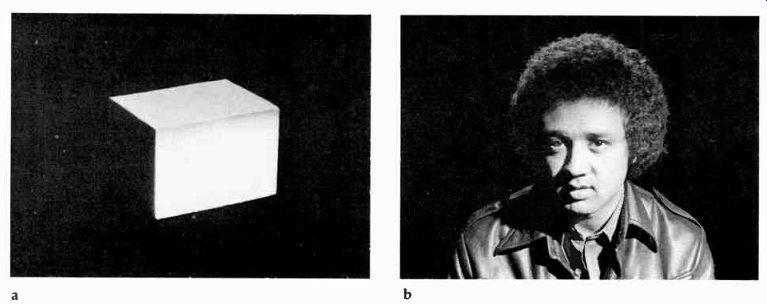
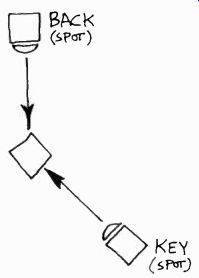
6.4 The back light helps to separate the object from its background and to
reveal more of the object's true form and dimension.
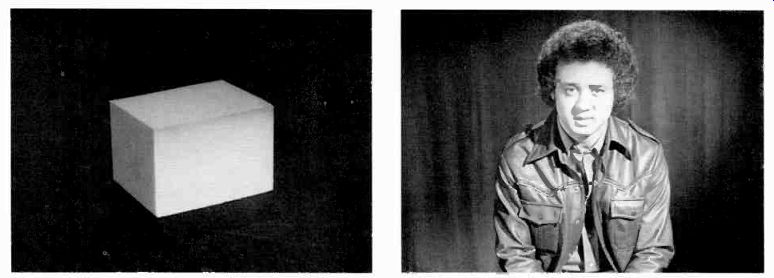

6.5 The fill light is placed opposite the key light to slow down falloff
and to make the shadow areas more translucent.
You can fill in some of the shadows by placing a floodlight, generally a scoop, in front and a little to the side of the cube, on the opposite side of the camera from the key light. If you have a dimmer, put the fill light on a dimmer and see how you can render the shadow progressively translucent by supplying an increasing amount of fill light. (See 6.5 through 6.7.) Since you simply want to lighten up a shadow area rather than produce new, harsh shadows on the other side of the cube, your fill light should be reasonably diffused.
Sometimes you may find that the fill light spills into other set areas. If your scoops have a focus control, focus the beam to its narrowest spread.
Or, if you want even more beam control, you can use a Fresnel spotlight as fill light by spreading the beam as much as possible. With barn doors, you can then prevent part of the spread beam from hitting the other set areas.
For very soft fill, use softlights or broads with a light-diffusing scrim attached to them.
With the three main light sources in the triangle position, you have now established the basic photographic principle of television lighting. But you are not through just yet. You should now take a good hard look at the lighted object or, if possible, the studio monitor, to see whether or not the scene (in our case, the cube) needs some further adjustment for optimal lighting. Are there any undesirable shadows, or shadows that distort, rather than reveal, the object? How is the light balance? Does the fill light wash out all the necessary shadows? Or are the shadows still too dense? Is the key-fill combination too strong for the back light?
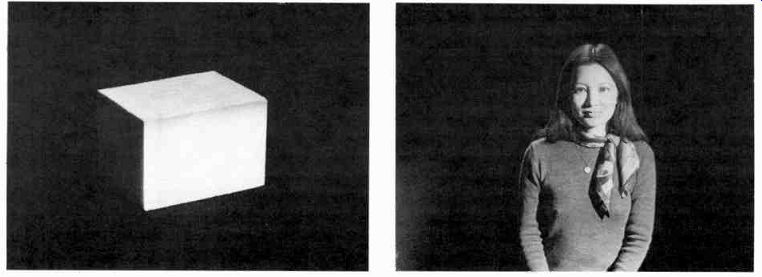

6.6 With too little fill, the shadow detail remains ambiguous.
We are obviously still concerned with the finer points of directional and intensity controls.
Let's replace the cube with a person, or, if you can't find anybody who wants to sit still for that long, with a plaster bust, and see what final adjustments might have to be made to the direction and intensity of the light beams.
Directional Adjustments
Assuming that you have hung all three light instruments-the key, the back, and the fill lights-into approximately the right triangular position and that you have pointed them reasonably well toward the subject, there are usually two major areas that need further attention: (1) vertical key light position and eye shadows, and (2) boom shadows.
Key Light and Eye Shadows
A fairly high key-light position, which means that the key light strikes the object from a steep angle, will cause large dark shadows under any protrusion or in any indentation, such as in the eye sockets, under the nose, and under the chin. If the subject wears glasses, you may find that the shadow of the upper rim of the glasses falls right across her or his eyes, thus preventing the camera (and the viewer) from seeing them clearly. (See 6.8a)
There are several ways of reducing these undesirable shadows. First, try to widen the angle of the key light by either lowering the light itself or using a key light farther away from the subject (see 6.8b). If you lower it (with a movable batten or a pantograph), you will notice that the eye shadows seem to move farther up on the face, or at least get smaller, the lower the key light moves and the nearer it approaches the subject's eye level. When the key light reaches eye level, the eye shadows will have disappeared altogether. If you move it below the eye level of the subject, however, the shadows will now reverse themselves, producing a ghostly and mysterious effect. You have seen these "lighting from below" effects many times in mystery movies (see 5.5b). Unfortunately, in television, where the cameras must move freely about the studio floor, lighting instruments that hang so low are a definite production hazard. Not only will they create a serious traffic problem, but they will also make it almost impossible for the other cameras to get a clear view of the scene, or for the boom to move about.
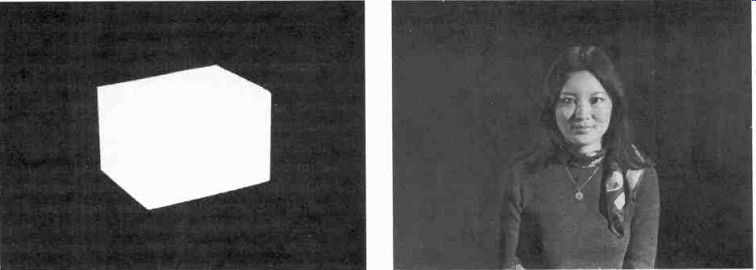
6.7 With too much fill, important form-revealing shadows are eliminated.
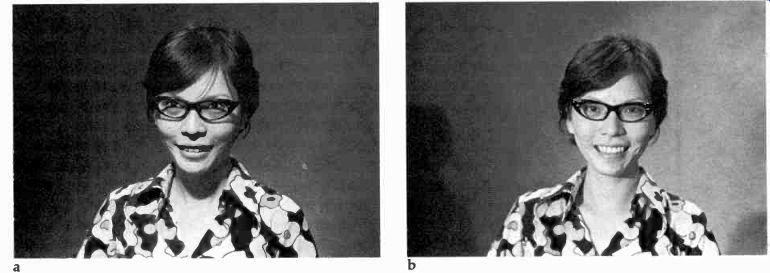
6.8 (a) The angle of the key light causes the upper rim of this woman's glasses
to fall right across her eyes. (b) By lowering the key light instrument somewhat,
you can eliminate the shadows.
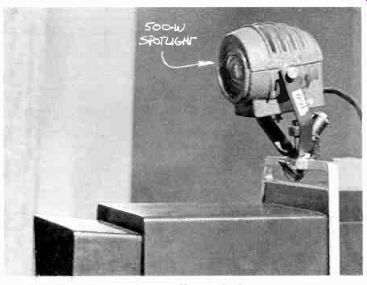
6.9 Camera Light: A small spotlight is sometimes mounted on the camera to
provide additional fill light, highlights (to add sparkle to eyes, for example),
or general illumination for easel cards.
But since the vertical positioning of the key light is so important to lighting aesthetics (illusion of reality and nonreality, and mood), you should nevertheless try to make the Fresnel spots, which are used mostly for key lighting, as vertically flexible as possible. Perhaps you might try to suspend them on pantographs, although such practice hasn't found much acceptance so far.
If you can't move the key light down closer to the eye level of the subject, try to use a Fresnel spot that is farther away. The light beam coming from a greater distance will necessarily strike the subject from a flatter angle and cause less prominent eye shadows.
The second method is to use a fill light that strikes the subject from a low angle. This is the preferred method of filling in eye shadows, since the fill lights will at the same time produce the necessary illumination for the baselight. Most scoops are, therefore, mounted on pantographs, or telescope poles, so that they can be pulled down into the desired low-angle fill position.
Some lighting experts prefer to point some of the scoops toward the light-reflecting studio floor.
This reflected, highly diffused, light will strike the subject from below eye level, filling in shadows without causing the ghostly from-below key light effect.
The third solution is to use a camera light, sometimes called inky-dinky, which is a small 150-watt baby spotlight mounted on the camera (see 6.9). This can be controlled by the camera operator through a small dimmer. Be careful not to dim the camera light too severely, especially on a closeup, or you will lower the color temperature of the lamp so much that the reddish light will cause color distortion.
Boom Shadows
Now if we move a boom microphone in front of the lighted scene-in this case a single person-and move the boom around a little, you may notice boom shadows whenever your microphone or the boom passes through a spotlight beam. (You can easily substitute a broomstick or the lighting pole for the boom.) The more diffused light of the scoop will cast a soft, less-defined shadow. One obvious solution to this problem is to light everything with diffused light, so that the shadows are barely noticeable. Or, you may want to "wash out" the boom shadow with additional fill light. Both of these methods are unacceptable, since they cause also the elimination of needed shadows, making the lighting too flat.
What we must do instead is to light in such a way that the boom shadows are cast into places where the camera will not see them. Whenever a boom is used, try to position the boom or the key light in such a way that the boom will not have to travel through the key light. Or, you may have to light steeper than usual (use a spotlight that hangs overhead, yet fairly close to the subject, so that it has to be pointed down at a steep angle) in order to throw the boom shadows onto floor areas that are hidden from the camera's view.
Barn-dooring off part of the key light is another useful method of avoiding some of the boom shadows.
The easy way out, of course, is not to use the boom microphone but to rely on hand, desk, or lavaliere microphones (see Section 7). The nature of the show, however, may make their use not always possible or desirable.
Intensity Adjustments
Even if you have carefully adjusted the position and beam of the key, back, and fill lights, you will still need to balance their relative intensities. In fact, it is not only the direction of the lights that will orient the viewer in time, for example, but also their relative intensities. A strong key and back, and a low-intensity fill light can create the illusion of sunlight, while a strong back light, extremely low key, and medium-intensity fill can suggest moonlight.' There is some argument about whether to balance the key and back lights first, or the key and fill lights. Actually, it matters little what you do first, as long as the end effect is a well-balanced picture.
We will, therefore, briefly talk about relative intensities, rather than priority. Again, you should realize that the proper balance depends on so many other production factors that it is impossible to give universally valid ratios. All we can do here is give you some basic clues.
Key-to-Back-Light Ratio
Generally, in normal conditions, back lights have approximately the same intensity as key lights. An unusually intense back light tends to glamorize the subject; a back light with an intensity much lower than that of the key will tend to get lost on the monitor. Without a strong back light, hair will look lifeless. A television performer with blond hair and a light dress or suit will need less back light than a dark-haired performer in a dark dress or suit.
The 1:1 key-to-back-light ratio (key and back lights have equal intensities) can go as high as 1:11/2 (the back light has 11/2 times the intensity of the key) if you need a fair amount of sparkle.
Key-to-Fill-Light Ratio
The fill-light intensity depends on how dense the shadows are that need to be filled and on the desired speed of falloff. If you want fast falloff, little fill will be needed. If you want very slow falloff, higher-intensity fill will be needed. It is, therefore, futile to state a standard key-to-fill-light ratio. Just for starters, you may want to try a fill-light intensity that is one-half that of the key light, and go from there. Just remember that the more fill light you use, the less modeling the key light is doing, since the form-revealing shadows are all but eliminated. If you use almost no fill light, the dense shadows reveal no picture detail, and you run the risk of serious color distortion in the shadow areas. If, for example, the detective refers to the small scar on the left side of a woman's face, and your closeup of her face shows nothing but a dense shadow where the scar should be, your key-to-fill-light ratio is obviously wrong.
Again, as helpful as light meters are to establish rough lighting ratios, don't rely solely on them.
Your final criterion is how the picture looks on the monitor.
Since you are now aware of the range of lighting ratios, you can try to light a person with the following intensities: key light, 200 ft-c; back light, 200 ft-c or slightly more; fill light, 100 ft-c, and background illumination of approximately 100 ft-c. (See 6.10.) Your ratios in this setup are: key to back 1:1, and key to fill 1:1/2. The combination of these light intensities should give you a baselight illumination of approximately 200 ft-c to 230 ft-c.
If this level is too high for you, simply dim the whole setup down a little. Be careful not to dim too heavily; otherwise the color-temperature change will become noticeable on the monitor.
[1. Herbert Zettl, Sight-Sound-Motion (Belmont, Calif.: Wadsworth Publishing Co., 1973), pp. 44-45.]
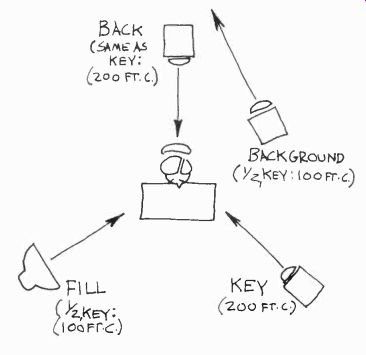
6.10 Lighting Ratios.
The Photographic Principle and Continuous Action
One added problem in television lighting is movement-movement of the performer or performers, and movement of the camera or cameras.
Fortunately, the basic photographic principle of key, back, and fill lights can be multiplied and used for each performing or set area. Even if you have only two people sitting at a table (see 6.11), you will have to use a multiple application of the photographic principle.
In order to compensate for the movement of the performers, you should illuminate all adjacent performance areas in such a way that the basic triangle-lighted areas overlap. The basic purpose of overlapping is to give the performer continuous lighting as she moves from one area to another.
It is all too easy to concentrate only on the major performance areas and to neglect the small, seemingly insignificant, areas in between. You may not even notice the unevenness of such lighting until the performer moves across the set. All of a sudden she seems to be playing a "now you see me, now you don't" game, popping alternately from a well-lighted area into dense shadow. This is the time when a light meter might come in handy. To spot such lighting "holes" before the cameras are on, take a foot-candle meter and pan it smoothly along the set area, as the camera would in following the performer. Watch the needle. If it doesn't fluctuate too much during the pan, your lighting is fairly even. If, however, your intensities change from 200 ft-c to 10 ft-c, and back to 185 ft-c, you will have to add more lights to even out the overall illumination.
In lighting several set areas at once for continuous action, you may find that you don't have enough instruments to apply the overlapping triangle lighting. You may then have to place the lighting instruments in such a way that each one can serve two or even more different functions (see 6.12). In reverse-angle shooting, for instance, the key light for one performer may become the back light for another, and vice versa. Or, you may have to use a key light to serve as directional fill in another area. Because of their diffused light beam, fill lights are often used to serve more than one area simultaneously.
Of course, the application of lighting instruments for multiple functions requires exact position of set pieces, such as tables and chairs, and clearly defined performing areas and blocking (movements of performers). Directors who decide to change blocking or move set pieces after the set has been lighted are not very popular with the lighting technicians.

6.11 Multiple Application of Lighting Triangle: In the multiple application
of the basic photographic principle, separate key and back lights are used
for each person (performance area). Note, however, that the same fill light
is used for both areas. Make sure that if person No. 1 is keyed from his left,
person No. 2 must be keyed from the left also. A key-light reversal (person
No.1 from left, person No. 2 from right) and the resulting shadow reversal
would be very confusing to the viewer, especially when persons No. 1 and No.
2 are separated by closeups.
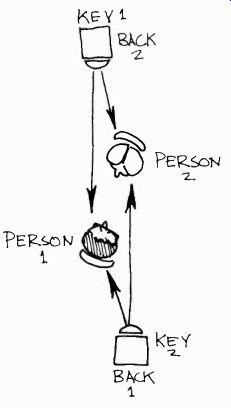
6.12 Multiple Function Lighting: In this multiple-function lighting, key
light No. 1 also functions as back light No. 2, and key light No. 2 as back
light No. 1.
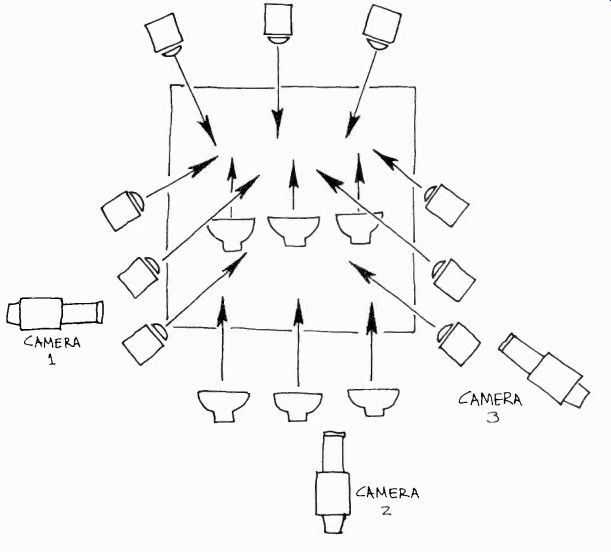
6.13 Large Area Lighting: Large area lighting usually employs cross-keying,
whereby the Fresnel spotlights assume multiple functions. From one side they
serve as key lights; from the other, as directional fill; and from a side
camera position, they may even act as back lights. The regular back lights
are strung out behind the main action area, opposite the major camera positions.
If any fill is necessary, it usually comes directly from the front. In effect, we have simply partially overlapped the triangles of the basic photographic principle.
Accurate lighting is always done with a basic camera position and viewpoint in mind. It helps greatly, therefore, if the lighting technician knows at least the basic parameters of the camera movement. For example, an object that appears perfectly well lighted from a six o'clock camera position may look woefully unlit from a ten o'clock camera position. Sometimes, as in variety shows, for example, "unlighted" shots from shooting angles that lie outside the lighted parameters may look quite dramatic; in most other shows of less flexible lighting formats--news shows, interviews--these shots simply look bad.
For lighting a large area, such as an audience area or an orchestra, the basic photographic principle still holds. All you do is partially overlap one triangle over another, until you have adequately covered the entire area. However, instead of key-lighting just from one side of the camera and fill lighting from the other, you key-light from both sides of the camera. This method is generally called cross-keying (see 6.13). The key lights from one side act as fill for the key lights from the other side. The back lights are strung out in a row or a semicircle opposite the main camera position.
The fill lights, if necessary, come directly from the front. If the cameras move to the side, some of the key lights also function as back lights.
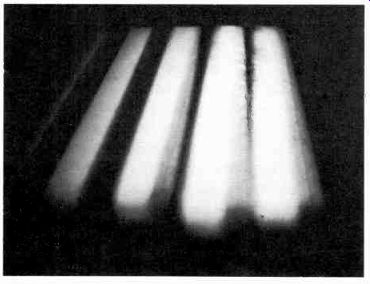
6.14 Background Lighting: Through a change in background lighting, you can
easily effect a change in locale, with no rearrangement of the actual lighting
of the performance area. As you can see here, we can transform a scene from
a prison to a church by a mere change of cookies (background projection).
Together with appropriate music, such a change is entirely convincing to the
viewer.
-----------
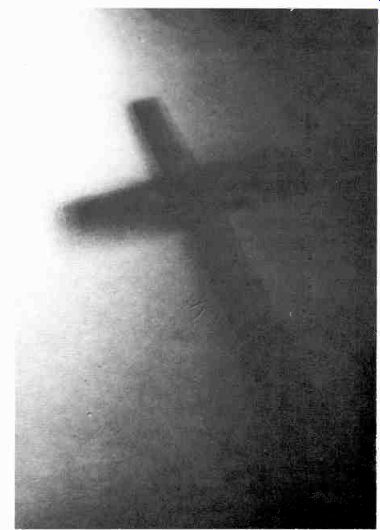
6.15 Don't confuse low-key and high-key with low and high vertical positions
of the key light. They refer to the general mood of the lighting. Low-key
means dark background, low overall light level, and fast falloff lighting,
usually with strong back lights.
High-key means generally a light background, bright overall illumination. The falloff may be fast (for sunshine) or slow (for bright, overcast outdoor scenes, or evenly lighted indoor scenes).
--------------
Additional Light Sources
Several additional light sources are often used in connection with the basic photographic lighting setup. They include (1) the background or set light, (2) the side light, (3) the kicker light, and (4) the camera light.
The basic functions of the additional light sources are to sharpen the viewer's orientation in space and time, to add sparkle and snap to the picture, and to help establish a general mood. In short, they help in clarifying and intensifying the screen event for the viewer.
Background or Set Light
The most important additional light source is the background light or, as it is frequently called, the set light. Its function is to illuminate the background (walls, cyclorama) of the set, or portions of the set that are not a direct part of the principal performing areas (see 6.14). This light frequently goes beyond its mere supporting role to become a major production element. Besides accentuating an otherwise dull, monotonous background with a slice of light or an interesting cookie, the background light can be a major indicator of the show's locale, time of day, and mood. For example, a cookie projection of prison bars on the cyc, in connection with the clanging sounds of cell doors closing, will immediately set the scene. Simply by replacing the prison bar cookie with that of a cathedral window or silhouette of a cross, and the clanging sounds with organ music, we will have transferred the prisoner instantaneously into a different environment, without ever touching the lighting on the actor himself.
A long slice of light, or long shadows, falling across the back wall of an interior set will suggest, in connection with other congruent production clues, late afternoon or evening.
Dark backgrounds suggest, of course, a downward, low-key mood; light backgrounds an upbeat, happy mood. (See 6.15.) Colored background lighting plays an especially prominent role in the production of musical shows and dance performances. You can achieve a variety of moods, or pure visual excitement, through certain combinations and changes of background colors. In certain instances, where you light more for the expressive intensification than for the clarification of the event, such as a rock concert, you may even use colored lights in the performance areas. Be very judicious here, however, as the undistorted skin tones are the principal color reference for the viewer, who has no way of knowing just what colors you are broadcasting. Colored lights in performance areas obviously render this common reference worthless.
In normal background lighting of an interior setting, for example, try to keep the upper portions of the set rather dark, with only the middle and lower portions (such as the walls) illuminated.
The reasons for this common lighting practice are quite apparent: First, most indoor lighting is designed to illuminate low working areas rather than the upper portions of the walls. Second, the performer's head will be more pleasingly contrasted against a slightly darker background. Too much light at that height might cause a silhouette effect, rendering the face unusually dark. On the other hand, furniture and medium- and dark-colored clothing are nicely set off from the lighter lower portions of the set. Third, the dark upper portions hide the lack of a ceiling and help to eliminate undesirable boom shadows.
You can darken the upper portions of the set rather easily by barn-dooring off any spotlight (including the background lights) that would hit those areas.
Make sure that the background lights strike the background from the same side as the key strikes the subject. Otherwise we may assume that there are two separate light sources illuminating the scene or, worse, that there are two suns in our solar system. (See 6.16.)

6.16 Direction of Background Light: When using a background light, make sure
that the background light and the key light come from the same direction.
Otherwise, the viewer experiences a shadow reversal in the same shot.

6.17 Side Light: The side light, striking the subject from the side, acts
as additional fill light and provides contour accents. It can also act as
a key light for extreme camera position.
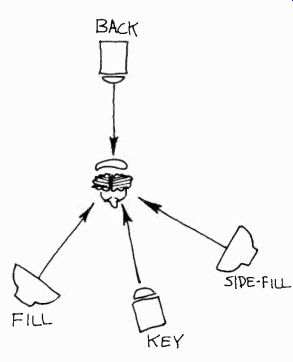
6.18 Side Fill Light.
The Side Light
Generally placed directly to the side of the subject, the side light is used in place of or, more frequently, in addition to the fill light. It helps to reduce dense shadows that are not reached by the front fill light, and accentuates the contour of the subject. It becomes an essential light source if the camera's shooting parameter is exceptionally wide. If, for instance, the camera arcs around the subject from a six o'clock position to a ten o'clock position, the side light will take on the function of the key light and provide essential modeling (lighting for three-dimensional effect). (See 6.17.) Fresnel spotlights, with a wide beam, are generally used for side lighting.
For brilliant high-key lighting, you may find it helpful to support the key light with side fill light.
This gives the "key" side of the subject basic illumination, with the key light providing the necessary sparkle and accent. For such side lighting you use, of course, a floodlight rather than a spotlight. (See 6.18.)
The Kicker Light
The kicker light, generally a sharply pinned Fresnel spot, strikes the subject from behind and off to one side. Its main purpose is to highlight the contour of the subject at a place where key-light falloff is the densest, where the dense shadow of the subject opposite the key-lighted side tends to merge with the dark background. The function of the kicker is quite similar to that of the back light, except that the kicker light "rims" the subject not at the top-back, but at the lower side-back. It usually strikes the subject from below eye level. (See 6.19.) Kicker lights are especially useful for creating the illusion of moonlight.2 Special Lighting Techniques Four special lighting techniques deserve our further attention: (1) cameo lighting, (2) rear screen lighting, (3) chroma key lighting, and (4) remote lighting.
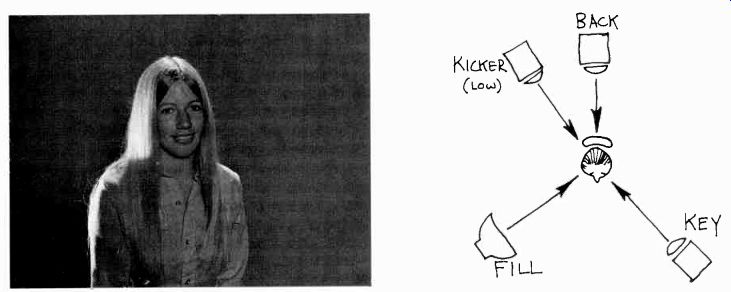
6.19 Kicker Light: The kicker light rims the object opposite the key and
thus emphasizes contour. Like the back light, the kicker helps to separate
the object from the background.
Cameos
Certain television shows, especially those of a dramatic nature, are staged in the middle of an empty studio against an unlighted background.
This technique, where only the performers are highlighted against a dark background, is commonly known as cameo lighting (from the cameo stone in which a light relief figure is set against a darker background stone). All cameo lighting is highly directional and is achieved entirely with spotlights. In small studios, the background areas are carefully shielded with black, light-absorbing draperies from any kind of distracting spill light.
While cameo lighting is a highly effective technique in monochrome television, it is rather difficult to handle in color. The major problems are the high contrast, dense shadows, and the low baselight levels, all adverse factors to good color lighting. However, in certain circumstances, cameo lighting can, even in color, be highly effective.
Rear Screen Performance Area
For some kinds of shows, a picture of a scene is thrown onto the rear screen from the reverse side.
The translucent screen allows the camera to pick up the projected image from the front.
The intensity of such a rear screen projection depends, like any ordinary slide projector, on the power of the projector. But even the most powerful home slide projector will produce pictures of poor quality if you turn on the lights or open the curtains and allow sunlight to flood the room.
Similarly, any light that falls on the rear screen projection damages the picture partially or fully.
Lighting in its close vicinity, therefore, must be highly directional. You can use only spotlights with barn doors carefully adjusted so that no spill light will hit the screen. You must also move performers and lighted set pieces at least six feet away from it. Since the lighting area in front of the rear screen is confined, the performers are restricted in their movements. In general, only stationary action is possible. Should the performer walk back to the rear screen, he or she would move beyond the performance area lights and would change immediately into a dark silhouette against the bright rear screen.
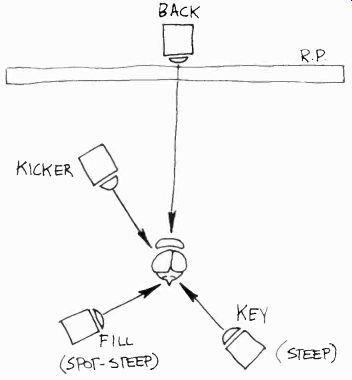
6.20 Lighting for the Rear Screen: Lighting for the rear screen requires
highly directional light sources that do not produce any light spill on the
projection. The performer must be some distance away from the screen in order
to avoid spill and silhouette effects.
When the rear screen slide is exceptionally bright, you may get a silhouette effect, since your performance area lighting may not be enough to offset the brightness of the slide. You may try to use additional lights (directional fill) to brighten up the performer's face. But each additional light source, in turn, increases the light spill on the rear screen. As you can see, rear screen lighting is anything but easy. (See 6.20.) When you have to light several sets besides the rear screen area, the inevitable spill light and the high amount of baselight may cloud the rear screen projection. This cloudiness occurs most often in small studios, where the sets are necessarily close together. The only solution is to separate the performing areas as much as possible and to keep them on opposite sides of the studio so that the lighting is directed away from the rear screen. If the spill-light problem becomes too great, a photo mural may have to be substituted for the light-sensitive rear projection.
Careful pinning of the Fresnel spots, and equally careful barn-dooring, will help you to achieve the necessary directional control for rear screen lighting. Also, you may have to key-light and fill-light from steeper than normal lighting angles in order to avoid hitting portions of the rear screen with the light beam.
Chroma Key Set Area
The chroma key set area consists of a blue background and the foreground area, such as a newscaster's desk or interview chairs and table. The blue background is used for chroma key matting. The most important aspect of lighting the chroma key set area is even background illumination.
In order to achieve an optimally effective chroma key matte, the blue background must be lighted with highly diffused instruments, such as soft-lights or scoops with scrim attachments. If there are hotspots on the blue background, or unusually dark areas, the matte (electronically supplied background image) will look discolored, or, worse, will have a tendency to break up. When lighting the foreground set, make sure that there are no spotlight beams hitting the background area so that you can preserve the evenness of the chroma key background illumination.
Sometimes you may have noticed that the outline of the newscaster vibrates with a variety of colors, or that the contour is not sharp during a chroma key matte. One of the major reasons for such moiré effects (vibrating color patterns) is that especially dark colors or shadows at the contour line take on a blue tinge, similar to the blue of the background. During the chroma key process, these blue spots become transparent and let the background picture show through. In order to counteract the bluishness of the shadows, you might try putting yellow or light orange gels (color filters) in all of the back lights or kicker lights. Thus, the back lights not only separate the foreground subject from the background picture through contour illumination, but also neutralize the blue shadows through the complementary yellow color. Be careful, however, not to let any of the yellow light hit the face, arms, or hands of the newscaster.
Remote Telecasts-- Because of severe limitations in time, space, manpower, and facilities, precise studio lighting can rarely be duplicated on remote locations. Fortunately, remote telecasts rarely demand subtle aesthetic lighting effects; they need mostly a basic functional light level so that the camera can see well, or at least adequately. Therefore, the major objective in remote lighting is, as already mentioned, to provide a fairly even, operational light level with a minimum of lighting instruments.
Almost more than in the studio, the lighting technician should consult with the director as to where the performance areas are, what the cameras are supposed to see, and what the nature of the event is.
Low ceiling heights are generally the most serious problem, especially for setting back lights. Try to suspend the back lights from small wooden battens that you have positioned close to the ceiling by lightweight stands or polecats (spring-loaded aluminum poles that can be wedged between floor and ceiling). If you find that all you can do is hide one back light in one corner of the room, spread the light beam so that it covers as large a back light area as possible. In some instances, you may have to work only with top light, or without back lights altogether. Yet, try to get some back lights into the location, even if it takes an extra effort. Hurried remote lighting looks characteristically flat and dull, not because of the diffused light used for key and fill lighting, but because of a lack of back lighting.
As mentioned before, floodlights, or combination lights, such as focusing broads, are more effective in remote lighting than highly directional spotlights.
You will find that on most remote telecasts the cameras will inevitably have to look through a door toward one or several windows. Don't try to use the outdoor light for your indoor shooting.
In order to avoid a silhouette effect, you must block, at least partially, the excessive window light by drawing curtains or shutters. There are also large sheets of plastic filters available which, when placed over the windows, reduce the incoming light and lower the color temperature to that of the indoor lights (3,200° K).
==================
6.21 Table of Lighting Instruments.

====================
Operation of Lights
When initially hanging the lights, divide the studio into major performance areas and hang the appropriate instruments (spotlights and floodlights) in the triangular arrangements of the basic photographic principle. Try to position the instruments so that they can serve multiple functions.
This procedure will help you to illuminate all major performance areas adequately with the least number of instruments and effort.
In the actual operation of lighting instruments and the associated control equipment, you should heed the rule for all production activities: safety first. Secure the lighting instruments to the battens by safety chains. If you have pantographs, make sure that they are securely fastened to the battens, and the light instruments safety-chained to the pantographs. Chain all barn doors to the instruments. If you have diffusers in front of the scoops, make sure that they are securely fastened in place.
Check all C-clamps periodically, especially the bolts that connect the lighting instruments to the hanging device.
When the lights are on, be very careful when moving the instrument. Since the hot lamps are especially vulnerable to physical shock, try not to jolt the lighting instrument. Move it gently.
Whenever you adjust the beam, such as the focus device or the barn doors, without the use of a light pole, make sure that you wear gloves. The quartz lights especially get extremely hot.
When moving ladders for fine trimming (fine beam adjustment), watch for obstacles below and above. Don't take any chances by leaning way out to reach an instrument. Move the ladder.
When adjusting a light, try not to look directly into it. Rather, look at the object to be lighted and see how the beam strikes it. If you have to look into the light, wear dark glasses.
When patching lights at the patchboard, have all dimmers in the "off" position. Do not "hot-patch"; otherwise, the patches themselves will become so pitted that they no longer make the proper connection.
Try to "warm up" large instruments through reduced power. You will not only prolong the lamp life but also prevent the Fresnel lenses from cracking.
Don't overload a circuit. It may hold during rehearsal but then go out just at the wrong time during the actual show.
Don't waste energy. Bring the lights up full only when necessary. Dry runs (without cameras) can be done just as efficiently when illuminated by work lights as with full studio lighting.
------------------

6.22 A word about checking your lighting on the studio monitor. As we have
said before, your lighting is correct if the studio monitor shows what you
want the viewer to perceive. In order to get to this point, you should use
the monitor as a guide to your lighting, rather than the less direct light
meter. But you may run into difficulties. Your video engineer will tell you
that he cannot align the cameras before you have finished the lighting. And
your argument may be that you cannot finish the lighting without checking
it on the monitor.
Let's approach this argument with a readiness for compromise, since both parties have a valid point.
You can do the basic lighting without the camera.
A foot-candle meter will help you in detecting gross inadequacies, such as insufficient baselight levels, or extremely uneven illumination. With some experience, you will also be able to tell whether or not a shadow is too dense for adequate reproduction of color and detail. But then, for the fine trimming, you will need at least one camera. Ask the video engineer to work with you. After all, it is his or her responsibility, too, to deliver technically acceptable pictures. This single camera can be roughly aligned to the existing illumination and pointed into the set.
With the direct feedback of the picture on the studio monitor, you can now proceed to correct glaring discrepancies, or simply touch up some of the lighting as to beam direction and intensity.
After this fine trimming, all cameras can thep be aligned and balanced for optimal performance.
--------------------
Summary
In all television lighting, the basic photographic, or triangle, lighting principle of key, back, and fill light is used. The key light is the principal source of illumination, which reveals the basic shape of the object. The back light distinguishes the shadow of the object from the dark background and emphasizes its outline. The fill light makes the shadows less dense.
In lighting for continuous action, we can use multiple lighting triangles (each one consisting of key, back, and fill) that overlap.
Additional light sources are often used in connection with the basic photographic lighting setup.
These are (1) the background, or set, light, which illuminates the background of the scene; (2) the side light, which acts as a directional fill, generally opposite the key light; (3) the kicker light, which is used to highlight the contour of an object that would otherwise blend in with the background; and (4) the camera light, which acts as an occasional additional fill light.
Special lighting techniques include (1) cameo lighting, (2) rear screen lighting, (3) chroma key lighting, and (4) remote lighting.
In the operation of lights, safety is the first principle, as it should be in any other television operation.
The table of lighting instruments applies to a small- to medium-size studio in which monochrome or color cameras are used.